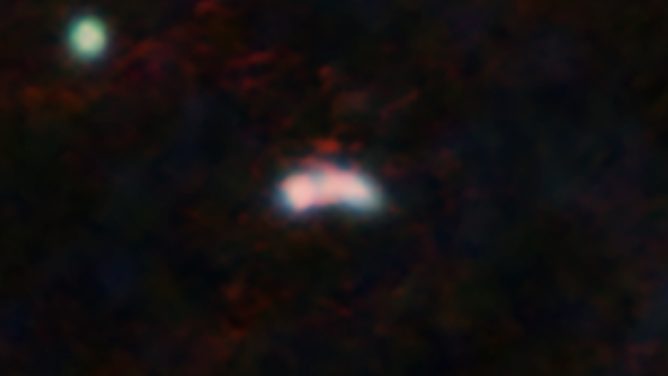2023.12.22
A Dancing Ancient Galactic Disk at a Peak of Star Formation
An international research team, led by Dr. Takafumi Tsukui from Australian National University, investigated the detailed gas movements in the galaxy BRI 1335-0417, a galaxy actively forming stars when the Universe was only 10% of its current age, using the ALMA (Atacama Large Millimeter/submillimeter Array) Telescope in Chile. The team reveals vertically oscillating waves (akin to seismic waves) forming in the flat disk structure of the galaxy. The vertically oscillating motions of the gas disk are caused by an external source, either from new gas streaming into the galaxy or by coming into contact with other smaller galaxies. Both possibilities would bombard the disk with new fuel for star formation. This discovery reveals the dynamic growth of a young galaxy actively forming stars in the early Universe.
Early galaxies have been found to form stars at a rate far exceeding that of modern galaxies. BRI 1335-0417, despite having a mass similar to the Milky Way galaxy, forms stars at a rate several hundred times faster. How is gas – the ingredient of stars – supplied to keep up with such a high rate of star formation? The key to understanding this process is to find out the movements and distribution of gas within the galaxy. Astronomical observations allow us to measure the gas movements in a galaxy by analyzing the wavelength change of light emitted by the gas as it moves towards or away from the observer. However, detailed measurement of the gas velocity in distant early galaxies has been possible only for a handful of galaxies due to the limited sensitivity of telescopes. In the case of BRI 1335-0417, one of the brightest distant galaxies in infrared, high-sensitivity observations by the ALMA allow them to examine the gas motions in as much detail (about 70 different regions in the galaxy!) as for nearby galaxies.
Dr. Tsukui analyzed the high-quality gas velocity data of BRI 1335-0417 by subtracting the global rotational motion of the galaxy disk. The remaining small-scale gas motion shows a spiral pattern aligned with the gas distribution (Fig1). These features are typical of the seismic wave phenomenon in galaxy disks seen in numerical simulations. While the rotational motion is relatively easy to measure due to its large velocity difference and large spatial scale, measuring the seismic waves in a disk with a small velocity difference and small spatial scale has been challenging, and this is the first time such measurements have been made in a distant galaxy.

Fig1. Left: the gas distribution. Middle: the gas movements due to small scale seismic motions revealed in BRI 1335-0417 with spiral arm patterns shown in black line. Blue parts move towards us, while red parts away from us.
(Credit: ALMA (ESO/NAOJ/NRAO), T. Tsukui et al.)
Right: similar distribution and movements are seen in a numerical simulation forming seismic waves in a galactic disk. The red box shows a similar field of view to the observation.
(Credit: Bland-Hawthorn and Tepper-Garcia 2021)
Furthermore, the study of the gas distribution reveals a bar-like structure in the disk. Galactic bars are part of some galaxies, like our Milky Way, and can disrupt gas within galaxies and transport it towards the galaxy’s centre. The bar discovered in BRI 1335-0417 is the most distant such structure known. This galaxy is also the most distant spiral galaxy known to date. Spiral structures in the early Universe are rare, and the exact formation scenario is still unclear. The spiral structure aligns with the vertical wave structure in the disk, strongly suggesting that the same gas-infalling events created the spiral structure in this galaxy. This observation provides crucial information on the formation scenario of a spiral structure in early galaxies. The onset of bar and spiral structure in galaxies remains a cosmic mystery, which the newly launched James Webb Space Telescope (JWST) has also been exploring. The JWST, which can capture the distribution and motion of stars, may further our understanding of the formation processes of early spiral disk galaxies like BRI 1335-0417.
Significant opportunities remain for understanding the phenomena of the wave forming in the disk. The Gaia telescope, a specialized space telescope that measures precise positions and motions of 1.8 billion stars, recently revealed a vertical oscillation of our Milky Way galaxy disk. Through understanding the process, the computer simulations (by one of the co-authors, Prof. Joss Bland-Hawthorn and his colleague Dr. Thor Tepper-Garcia: Fig2) have shown a wave structure in the disk similar to what we observed in the early Universe. While it is impossible to observe the evolution of the galaxy directly, as observations provide only a snapshot, computer simulations informed by our observations can help piece together the exact origin and evolution of these phenomena.

Fig2. Simulation by Bland-Hawthorn and Tepper-Garcia illustrates a galaxy disk being disturbed, leading to the propagation of a seismic ripple throughout the disk. (Credit: Bland-Hawthorn and Tepper-Garcia, University of Sydney).
This research was published as “Detecting a disk bending wave in a barred-spiral galaxy at redshift 4.4” by Takafumi Tsukui et al. in the peer-reviewed journal Monthly Notices of the Royal Astronomical Society on 22nd of December, 2023.https://doi.org/10.1093/mnras/stad3588
Links









